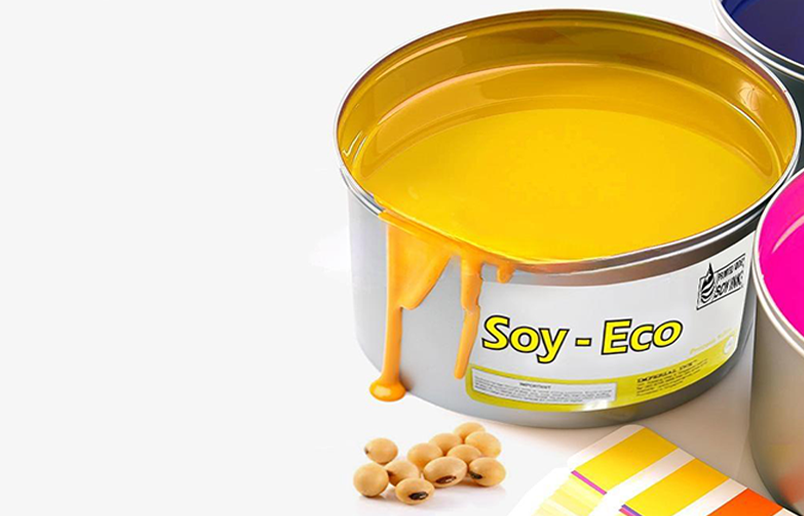In today’s environmentally conscious world, finding sustainable alternatives to everyday products and services is becoming increasingly important. For businesses and individuals seeking eco-friendly printing solutions, Soya Ink Printing Services has emerged as a compelling choice.
What Is Soy Ink?

Soy ink, derived from soybean oil, is an eco-friendly alternative to traditional petroleum-based inks. It offers a sustainable and environmentally responsible option for all your printing needs. In this article, we’ll explore the critical aspects of soy ink and why it’s a viable choice for eco-conscious consumers and businesses.
Composition of Soy Ink
Soy ink is primarily made from soybean oil, along with other renewable and natural resources. This composition stands in stark contrast to conventional inks, which rely on petroleum-based solvents. Reducing petroleum products in soy ink is a significant step towards lowering our carbon footprint.
Environmental Benefits
One of the primary advantages of soy ink is its eco-friendliness. It’s biodegradable, which means that it decomposes more readily than petroleum-based inks, posing less harm to the environment. The use of soy ink also contributes to a significant reduction in VOC (Volatile Organic Compounds) emissions during the printing process, further promoting a cleaner and healthier atmosphere.
Superior Print Quality

While environmental benefits are a significant selling point, soy ink doesn’t compromise print quality. It often surpasses traditional inks regarding vibrancy, color saturation, and printing performance. Book printers and businesses in the printing industry appreciate the brilliance and sharpness of images achieved with soy ink, making it an ideal choice for high-quality projects.
Advantages of Using Soy Ink
When it comes to choosing the correct ink for your printing needs, soy ink offers several compelling advantages. Here are some key points that highlight why China Soya Ink Printing Services and eco-conscious individuals are turning to soy ink:
Sustainability and Reduced Environmental Impact
The environmental benefits of soy ink can’t be overstated. By using soybean oil as the primary ingredient, soy ink reduces our reliance on petroleum-based solvents. This transition is essential for reducing our carbon footprint and promoting a sustainable future. Choosing soy ink demonstrates a commitment to environmental responsibility.
Improved Print Quality
One common misconception is that eco-friendly choices may compromise quality. However, soy ink proves this notion wrong. It often outperforms traditional inks in terms of print quality. The colors soy ink produces are more vibrant and saturated, creating stunning visuals. Whether you’re a book printer looking to grow captivating book covers or a business aiming for eye-catching promotional materials, soy ink can elevate the quality of your prints.
Health and Safety Benefits
Soy ink is renowned for being safe for the environment and those working with it. It contains fewer harmful chemicals and emits fewer VOCs during the printing process, which is not only better for the planet but also promotes a healthier work environment. This is particularly important for those in the printing industry who constantly interact with inks and printing materials.
Compliance with Eco-Friendly Regulations
As environmental regulations become more stringent, soy ink can help businesses and individuals comply with these standards. Soy ink aligns with many eco-friendly initiatives and guidelines, making it a smart choice for anyone aiming to meet or exceed environmental requirements.
Common User Questions
As the interest in eco-friendly printing solutions grows, you might have questions about incorporating soy ink into your projects. Here are answers to common user questions related to soy ink:
Is Soy Ink Suitable for My Printing Project?
Soy ink is versatile and suitable for a wide range of printing projects. Whether you need to print brochures, catalogs, magazines, posters, or books, soy ink can meet your needs. It’s especially well-suited for projects that demand vibrant colors and sharp imagery, making it a top choice for marketing materials and publications.
How Does Soy Ink Compare in Cost to Other Inks?
The cost of soy ink is competitive with traditional ink. While it might be slightly more expensive, the difference is often negligible, especially considering the overall quality and environmental benefits. Any minimal increase in cost is often outweighed by the advantages of choosing an eco-friendly option.
What Are the Color Options Available with Soy Ink?
Soy ink offers a wide range of color options, and it’s known for producing vivid and rich colors. This makes it suitable for projects that require color accuracy and intensity. Your print service provider can guide you in choosing the color options to achieve the desired results for your specific project.
Does Soy Ink Require Special Printing Equipment or Processes?
Usually, soy ink can be used with standard printing equipment and processes. This means you don’t need to invest in specialized machinery or significantly change your printing workflow. It’s a seamless transition to eco-friendly printing without significant disruptions.
Choosing Soy Ink Printing Services
Selecting the right printing service provider for your eco-friendly project is crucial to ensure you receive the best results when using soy ink. Here are some essential steps to guide you in choosing the right Soya Ink Printing Services:
Identifying a Reputable Printing Service Provider
- Research: Start by researching and identifying companies offering soy ink printing services. Look for companies with a reputation for quality and sustainability.
- Reviews and Recommendations: Read customer reviews and seek recommendations from businesses or individuals who have experience with eco-friendly printing. Their insights can be invaluable in your decision-making process.
- Eco-Friendly Certifications: Check if the printing service provider holds eco-friendly certifications or affiliations, such as FSC (Forest Stewardship Council) or other environmental accreditations.
- Samples and Portfolios: Request samples of their work or review their portfolio to assess the print quality and their ability to meet your specific project requirements.
Requesting Soy Ink as an Option
Once you’ve identified a potential printing service provider, you must communicate your preference for soy ink. Here’s how you can go about it:
- Consultation: Schedule a consultation with the printing company to discuss your project. Clearly express your desire to use soy ink and ask for their expertise in implementing it effectively.
- Sample Proofs: Request sample proofs using soy ink to evaluate the quality and vibrancy of prints. This step ensures that the chosen ink meets your expectations.
- Pricing and Quotations: Discuss pricing and obtain quotations for your project. Compare the cost with the environmental and quality benefits to make an informed decision.
- Project Requirements: Share detailed information about your project, such as the type of material, quantity, and deadlines. Clear communication is essential for a successful partnership.
Case Studies and Success Stories
To further illustrate the advantages and real-world impact of using soy ink in printing projects, let’s explore some compelling case studies and success stories:
Case Study 1: Sustainable Marketing Campaign
A leading marketing agency sought to create a sustainable marketing campaign for a prominent client. They partnered with a printing service provider offering soy ink printing. The result? A stunning set of marketing materials featuring vibrant colors and exceptional print quality. The eco-friendly approach aligned with the client’s values and garnered positive feedback from their target audience, contributing to the campaign’s success.
Case Study 2: Educational Publishing
A renowned educational publisher switched to soy ink for their textbook printing. By using soy ink, they achieved exceptional color clarity and sharp text, enhancing the learning experience for students. The decision not only improved print quality but also showcased the publisher’s commitment to environmentally responsible practices.
Case Study 3: Eco-Friendly Branding
A small business specializing in artisanal products recognized the need to align their branding with eco-conscious values. They collaborated with a local Soya Ink Printing Service to create product labels and packaging using soy ink. The result was a distinctive, environmentally friendly brand identity that resonated with customers and set them apart from competitors.
Success Story: Environmental Impact
A medium-sized printing company switched to soy ink across all their projects. Over time, this transition significantly reduced their environmental impact. They saw a substantial decrease in VOC emissions and a positive response from clients who appreciated the company’s commitment to sustainability. The business not only thrived but also contributed to a greener planet.
These case studies and success stories demonstrate that choosing Soya Ink Printing Services can lead to successful projects, enhanced print quality, and positively impacted brand image. It’s a win-win for both the environment and your printing needs.
Tips for Maximizing the Benefits of Soy Ink
To make the most of soy ink and ensure your eco-friendly printing projects are successful, consider these valuable tips:
Design Considerations
- Color Selection: Leverage the vibrant color options of soy ink to create eye-catching visuals in your design. Work closely with your graphic designer to maximize the potential of soy ink.
- Paper Choice: Select eco-friendly and sustainable paper options to complement the green printing process. Recycled or FSC-certified papers are excellent choices.
- Graphic Resolution: Use high-resolution graphics and images to maximize soy ink’s sharp printing capabilities.
Proper Care
- Storage: Store printed materials in a dry and relaxed environment to maintain quality and prevent ink degradation.
- Handling: When distributing or shipping printed materials, handle them carefully to prevent scratches or scuffs.
- Eco-Friendly Disposal: Encourage recycling or responsible disposal of printed materials, as soy ink is biodegradable.
Promoting Eco-Friendliness
- Labeling: Include eco-friendly labels or certifications on your printed materials to inform your audience of your commitment to sustainability.
- Marketing: Emphasize your use of soy ink and eco-friendly printing practices in your marketing and branding efforts. It can be a unique selling point that attracts environmentally conscious customers.
By implementing these tips, you can ensure that your soy ink printing projects are not only environmentally responsible but also visually appealing and effective in conveying your message.
Soy Ink vs. Other Eco-Friendly Inks
Soy ink is not the only eco-friendly ink option available. Here’s a brief comparison of soy ink with other environmentally responsible inks:
Soy Ink vs. Vegetable-Based Inks:
While soy ink is primarily derived from soybean oil, vegetable-based inks can be made from various plant sources. Both offer eco-friendly benefits, but soy ink often outperforms print quality and sustainability.
Soy Ink vs. Water-Based Inks:
Water-based inks are known for their low environmental impact, but they can have limitations regarding vibrancy and color saturation. Soy ink strikes a balance between eco-friendliness and print quality.
Soy Ink vs. UV Inks:
UV inks are cured using ultraviolet light, making them eco-friendly and reducing emissions. However, soy ink may be less biodegradable than they are and have specific applications.
Your choice of ink should align with your project’s specific requirements, environmental considerations, and desired print quality.
Conclusion
In a world where sustainability is increasingly vital, choosing Soya Ink Printing Services and opting for soy ink is a responsible and intelligent choice. Soy ink offers many benefits, from vibrant print quality to environmental responsibility, and it can be seamlessly integrated into various printing projects.
As you embark on your printing endeavors, remember that your choice of ink can make a substantial impact, not only in terms of visual appeal but also in contributing to a greener planet. Eco-friendly printing is no longer a luxury; it’s a necessity that aligns with the values of a sustainable future. By selecting soy ink, you’re taking a significant step towards a more environmentally responsible printing industry.
In the grand tapestry of the printing world, your choice of ink is a brushstroke that colors not only your project but the larger canvas of our environment. It’s a testament to your commitment to eco-conscious practices and the well-being of our planet. As we move forward, let’s continue to choose eco-friendly options like soy ink, promoting a harmonious balance between our printing needs and a sustainable future.




